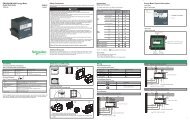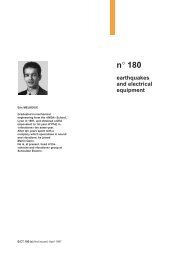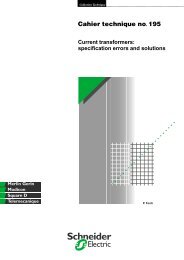Low Voltage circuit-breaker breaking techniques - Schneider Electric
Low Voltage circuit-breaker breaking techniques - Schneider Electric
Low Voltage circuit-breaker breaking techniques - Schneider Electric
- No tags were found...
You also want an ePaper? Increase the reach of your titles
YUMPU automatically turns print PDFs into web optimized ePapers that Google loves.
5 Breaking prospective currents (with limitation)5.1 DefinitionsProspective currentIn an installation, this is the current which wouldflow through a <strong>circuit</strong> if each connection devicepole or the fuse were replaced by a conductor ofnegligible impedance (IEC 60050).In a switchgear test <strong>circuit</strong>, it is the calibrationcurrent.Remember that:c under d.c. voltage, current evolution takes theform:E⎛ t ⎞ ⎛ t ⎞i = 1−eτR ⎜ ⎟ = I 1⎜− eτ(see fig. 13 ) ;p⎟⎝ ⎠ ⎝ ⎠c under single-phase a.c. voltage: the moment"of appearance of the fault" or the moment ofclosing, compared with mains voltage value,considerably influences evolution of the transientcurrent.If this moment were characterised by its closingvoltage angle α, voltage may be written as:u = E sin (ωt + α), (cf. fig. 14a )Current evolution takes the shape:i = E R⎡⎢sin ω t + α - ϕ sin α -⎢ϕ⎣( )− ( )R− ⎤e L t ⎥⎥⎦with two components:v an a.c. one, with a phase shift of ϕ withrespect to voltage,v a d.c. one, tending to zero when t tends toinfinity.Two special cases are defined by:v α = ϕ, known as the "symmetrical condition"(see fig. 14b )The current shape is:i= E R sin ωtRight from the start the current has the samecurve as in steady state, and a peak value ofE/Z.v α = 0, known as the "asymmetrical condition"(see fig. 14c ).The current curve is given by:i = E ⎡sin ( t - sin eR ω ϕ)+ϕ− R ⎤⎢L t ⎥⎢⎥⎣⎦Thus the first peak value of the current is afunction of the <strong>circuit</strong> cos ϕ.c under three-phase a.c. voltage (see fig. 15 )The current in each phase may result in thesame special cases (symmetrical andasymmetrical) as in single-phase. In any case,whatever the value of α, there is nearly always:c a phase in quasi-symmetrical condition,c a phase in quasi-asymmetrical condition,c the last phase is said to be in "small loop".abui«α»α = ϕi "symmetrical"ttciERI pERii "asymmetrical"tτtα = 0Fig. 13Fig. 14: current evolution under a.c. voltage.Cahier Technique <strong>Schneider</strong> <strong>Electric</strong> no. 154 / p.13
















